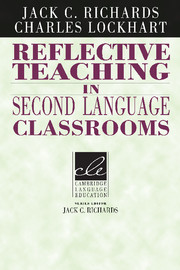Book contents
- Frontmatter
- Contents
- Series editor's preface
- Preface
- Introduction: Teacher development through exploring classroom processes
- 1 Approaches to classroom investigation in teaching
- 2 Exploring teachers' beliefs
- 3 Focus on the learner
- 4 Teacher decision making
- 5 The role of the teacher
- 6 The structure of a language lesson
- 7 Interaction in the second language classroom
- 8 The nature of language learning activities
- 9 Language use in the classroom
- Epilogue
- References
- Index
6 - The structure of a language lesson
Published online by Cambridge University Press: 29 January 2010
- Frontmatter
- Contents
- Series editor's preface
- Preface
- Introduction: Teacher development through exploring classroom processes
- 1 Approaches to classroom investigation in teaching
- 2 Exploring teachers' beliefs
- 3 Focus on the learner
- 4 Teacher decision making
- 5 The role of the teacher
- 6 The structure of a language lesson
- 7 Interaction in the second language classroom
- 8 The nature of language learning activities
- 9 Language use in the classroom
- Epilogue
- References
- Index
Summary
Lessons are events which are fairly easy to recognize. They take place in a particular setting (e.g., a school or classroom), they normally involve two kinds of participants (the teacher and students), and they normally consist of recognizable kinds of activities (e.g., the teacher lecturing at the front of the class, the teacher posing questions and calling on students to answer them). A lesson is, hence, distinguishable from other kinds of speech events, such as meetings, debates, arguments, or trials.
Like other speech events, however, lessons have a recognizable structure. They begin in a particular way, they proceed through a series of teaching and learning activities, and they reach a conclusion. This pattern of structure or organization is a result of the teacher's attempts to manage the instructional process in a way which will optimize the amount of learning that can take place in the time available. Wong-Fillmore (1985: 23–4) observes:
How classes are organized and how instructional events are structured determine to a large extent the nature of the language that students hear and use in the classroom. … Two sets of characteristics appear to distinguish classes that work for language learning from those that do not. The first set relates to the way the classes are structured or are organized for instruction, the second to the way language is used in lessons.
- Type
- Chapter
- Information
- Reflective Teaching in Second Language Classrooms , pp. 113 - 137Publisher: Cambridge University PressPrint publication year: 1994

